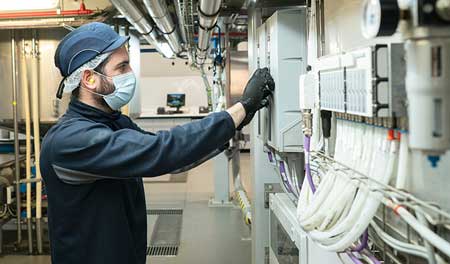| INTEGRATED REPORT 2020 |
We are providing employees with opportunities to learn, grow, and contribute to great results, while at the same time adapting to employees’ changing expectations of their employers.
Topic description
For PMI, talent management includes two primary areas of focus: Providing a workplace that is attractive to prospective employees and in which current employees can grow personally and professionally, and develop careers that satisfy and engage them; and responsibly addressing the future of work by considering the potential impacts of automation, digitalization, and business transformation.
Talent attraction, retention, and employability is a tier 2 topic within our strategic pillar Caring for the people we work with.

Our progress in 2020
read moreThe business case
Our business success over the long term relies on our ability to recruit and retain talented people. Their commitment and engagement are vital in every function of our business. The dedication, talent, openness, and passion of our employees enable and accelerate our company’s transition into a more consumer-centric organization increasingly focused on science and innovation. Investing in our people is therefore fundamental to our success now and in the future.
Achieving our aims
Our ambition is to attract the right people to our company and to encourage our employees to develop their careers with us. We aim to provide an environment of lifetime learning where talent can grow inside PMI, and which maintains our workforce’s high employability.

We’re moving from an era of lifetime employment to lifetime employee ability where if your people don’t feel that they learn and progress and they’re up to speed in their areas of expertise, they will leave you because they will become themselves obsolete.
PMI’s vision of a smoke-free future helps to attract and retain talent. The opportunity to contribute to this purpose and such a massive business transformation is compelling to many, as is the chance to make a positive societal impact. The way we manage attraction, retention, and employability is supported by our policies and programs in workforce inclusion and diversity, in addition to our fair working conditions, and contributes to a workplace culture that has at its core an emphasis on respect for the individual and continual learning and development.
Our aim:
After conducting a global Transformation survey in 2019, we set an engagement target of +30 employee net promoter score (within a range of -100 to +100) by 2025.
In 2020, PMI was certified by the Top Employers Institute as a Global Top Employer for the fifth year in a row.
Initiatives such as the Thrive leadership program and the global online learning platform known as FUSE enable our people to develop their capabilities and skills in an easy-to-access way. Our Workplace Integrity policy, along with other internal policies, helps us to manage career progression, lifelong learning and rewards, and to ensure equal opportunities are provided to all our employees.

Our progress in 2020
read more
Performance metrics
view dataThis online content about our Integrated Report should be read in conjunction with PMI’s 2020 Integrated Report. The information and data presented here cover the 2020 calendar year or reflect status at December 31, 2020, worldwide, unless otherwise indicated. Where not specified, data come from PMI estimates. Please also refer to 'About this report' on page 3 of the 2020 Integrated Report for more information. Aspirational targets and goals do not constitute financial projections, and achievement of future results is subject to risks, uncertainties and inaccurate assumptions, as outlined in our forward-looking and cautionary statements on page 145. In the 2020 Integrated Report and in related communications, the terms “materiality,” “material,” and similar terms, when used in the context of economic, environmental, and social topics, are defined in the referenced sustainability standards and are not meant to correspond to the concept of materiality under the U.S. securities laws and/or disclosures required by the U.S. Securities and Exchange Commission.




